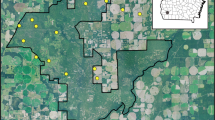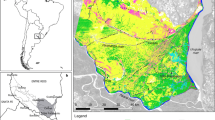Abstract
A goal of wetland restoration is to provide habitat for breeding populations of waterfowl and other bird species. To meet this goal, it is important to determine how birds respond to restored wetlands and which factors influence their use of restored wetlands. We examined the relationship between bird species richness and years since restoration at restored prairie wetlands in lowa. We detected 42 bird species in restored wetlands. 15 of which were breeding species. The mean number of breeding bird species was significantly greater in older restored wetlands (4.3 species in 1-year-old wetlands, 7.2 species in 4-year-old wetlands,p=0.005). The mean number of all bird species, waterfowl species, and breeding waterfowl species did not change with wetland age. Total and breeding bird species richness increased with percent cover of emergent vegetation. Waterfowl species richness and breeding waterfowl species richness were influenced more by wetland area than vegetation characteristics, whereas total species richness and breeding bird species richness were influenced more by vegetation characteristics. If the goal of restoration is simply to provide a breeding site for waterfowl, our data suggest that this can be done in a few years. However, we favor longterm restorations. Such restorations are more likely to have a more diverse bird community that more closely resembles those found in natural wetlands.
Similar content being viewed by others
Literature Cited
Batt, B.D.J., M.G. Anderson, C.D. Anderson, and F.D. Caswell. 1989. The use of prairie potholes by North American ducks. p. 204–227.In A. van der Valk (ed.) Northern Prairie Wetlands. Iowa State University Press, Ames, IA, USA.
Brown, M.W. 1985. Iowa marsh birds and the theory of island biogeography. M.S. Thesis. Iowa State University, Ames. IA, USA.
Dahl, T.E. 1990. Wetland losses in the United States 1780’s to 1980’s. U.S. Fish and Wildlife Service, Washington, DC, USA.
Delphey, P.J. 1991. A comparison of the bird and aquatic macroinvertebrate communities between restored and ‘natural’ Iowa prairie wetlands. M.S. Thesis. Iowa State University, Ames, IA, USA.
Delphey, P.J., and J.J. Dinsmore. 1993. Breedign bird communities of recently restored and natural prairie potholes. Wetlands 13:200–206.
Galatowitsch, S.M. and G.A. van der Valk. 1994. Restoring prairie wetlands. Iowa State University Press, Ames, IA, USA.
Galatowitsch, S.M. and A.G. van der Valk. 1996. The vegetation of restored and natural prairie wetlands. Ecological Applications 6:102–112.
Gibbs, J.P. and S.M. Melvin. 1993. Call-response surveys for monitoring breeding waterbirds. Journal of Wildlife Mangement 57:27–34.
Hemesath, L.M. and J.J. Dinsmore. 1993. Factors affecting bird colonization of restored wetlands. Prairie Naturalist. 25:1–11.
Kaminski, R.M., and M.W. Weller. 1992. Breeding habitats of Nearctic waterfowl. p. 568–589.In B.D.J. Batt, A.D. Afton, M.G. Anderson, C.D. Ankeyy, D.H. Johnson, J.A. Kadlec, and G.L. Krapu (eds.) Ecology and Management of Breeding Waterfowl. University of Minnesota Press, Minneapolis, MN, USA.
Kantrud, H.A., and R.E. Stewart. 1984. Ecological distribution and crude density of breeding birds on prairie wetlands. Journal of Wildlife Management 48:426–437.
Marion, W.R., T.E. O’Meara, and D.S. Maehr. 1981. Use of playback recordings in sampling elusive or secretive birds. Studies in Avian Biology 6:81–85.
Miller, L.D., M. Unverferth, K. Ghormley, and M.P. Skidla. 1990. A guide to MIPS: its features and applications. Microimages Inc., Lincoln, NE, USA.
Mueller-Dombois, D. and H. Ellenberg. 1974. Aims and Methods of Vegetation Ecology. John Wiley and Sons, Inc., New York, NY, USA.
National Research Council, Committee on Restoration of Aquatic Ecosystems. 1992. Restoration of Aquatic ecosystems: science, technology, and public policy. National Academy Press. Washington, DC, USA.
Rouvalis, M.C. 1988. Restoration of wetlands under section 404 of the clean water act: an analytical synthesis of statutory and case law principles. Environmental Affiars 15:295–347.
SAS Institute, Inc. 1988. SAS/STAT user’s guide, release 6.03 edition. SAS Institute, Inc., Cary, NC, USA.
Sewell, R.W. and K.F. Higgins. 1991. Floral and faunal colonization of restored wetlands in west-central Minnesota and northeastern South Dakota. p. 108–133In F.J. Webb, Jr. (ed.) Proceedings of the 18th Annual Conference on Wetland Restoration and Creation. Hillsborough Community College, Tampa, FL, USA.
Stewart R.E. and H.A. Kantrud. 1971. Classification of natural ponds and lakes in the glaciated prairie region. U.S. Fish and Wildlife Service Resource Publication 92. Washington, DC, USA.
U.S. Fish and Wildlife Service. 1987. Migratory nongame birds of management concern in the United States: The 1987 list. Office Migratory Bird Management, Washington, DC, USA.
VanRees-Siewert, K.L. 1993. The influence of wetland age on bird and aquatic macroinvertebrate use of restored Iowa wetlands. M.S. Thesis. Iowa State University, Ames, IA, USA.
Webster, J.T., R.F. Gunst, and R.L. Mason. 1974. Latent root regression analysis. Technometrics 16:513–522.
Weller, M.W. and C.E. Spatcher. 1965. Role of habitat in the distribution and abundance of marsh birds. Iowa Agriculture and Home Economics Experiment Station Special Report 43. Ames, IA, USA.
Wienhold, C.E. and A.G. van der Valk. 1989. The impact of duration of drainage on the seed banks of northern prairie wetlands. Canadian Journal of Botany 67:1878–1884.
Zar, J.H. 1984. Biostatistical Analysis. Second Edition. Prentice Hall, Englewood Cliffs, NJ, USA.
Zohrer, J.J. 1996. Iowa prairie pothoie joint venture 1995 status report. Iowa Department of Natural Resources. Des Moines, IA, USA.
Author information
Authors and Affiliations
Rights and permissions
About this article
Cite this article
VanRees-Siewert, K.L., Dinsmore, J.J. Influence of wetland age on bird use of restored wetlands in Iowa. Wetlands 16, 577–582 (1996). https://doi.org/10.1007/BF03161348
Received:
Revised:
Accepted:
Issue Date:
DOI: https://doi.org/10.1007/BF03161348




